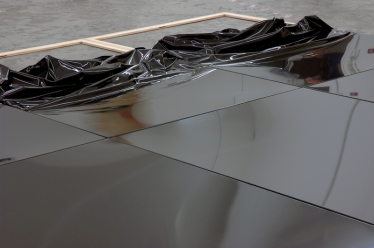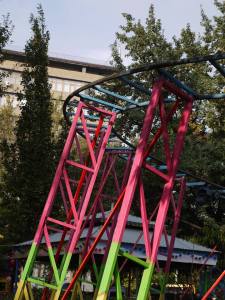Joel Morrison
Target Painting, 2015
Stainless steel
188 x 137,2 x 10,2 cm
© Joshua White – Courtesy of the Artist and Almine Rech Gallery
JOEL MORRISON
Steel Life Crisis
April 17 – May 16, 2015
Los Angeles-based artist Joel Morrison creates sculptures and wall works that are slick, highly polished and desirable. They are also changelings born from the waste and excess of a consumerist culture. His stainless steel artworks are dystopian aberrations made up of quotidian discarded objects found around his neighborhood and studio in Los Angeles. Broken bits of trolley, balloons, blankets and hammers are reassembled and repurposed into cool, luxe looking artworks. They are, Morrison calls them, “a collage of scenarios”. Often times amorphous and indeterminate, his works are dynamic and full of movement. Found objects are encased sarcophagus-like in a coat of stainless steel bulging and straining against their silver skin, struggling to break out.
Morrison critically addresses contemporary consumerist culture with his found object sculptures while playing with visual tropes of art history. A 2012 Hong Kong exhibition brought together references from classical Greek sculpture, Duchampian ready-mades, Arte Povera, and pop art. Like an alchemist Morrison deftly fuses and layers a palimpsest of references from music, pop culture, and art history. High and low culture, figuration and abstraction, the mechanical and handmade, are brought into union with irreverence and humour to create his own visual language.
Morrison’s works bridge the distance between viewer and art object, demanding engagement and interactivity. Using an approach to art production rooted in L.A’s Finish Fetish movement of the 1960s and ‘70s — characterized by its obsession with slick surfaces and polished perfection — Morrison takes advantage of the material he works with to play with temporality, and to ask questions about the viewer’s relationship to art. Like narcissus the viewer is seduced and drawn in by the reflective surface of the works. They abstract and distort everything they reflect in real time, lending the otherwise monochromatic pieces a mutable colour palette and contemporaneity. The works are both alien to their surrounding environment and part of it.
The freestanding and wall works give the appearance of spontaneity and immediacy, of objects haphazardly thrown together, but this belies the painstaking production process required to complete the works. Eschewing the typical route of mechanical big studio art production, Morrison makes his pieces from mold and lost wax casting: “the simplest and oldest method of replicating objects into metal.” The approach is lo-fi and old school, allowing for the artist’s hand to be glimpsed in a fingerprint, or indentations from the casts, raising questions about contemporary art production and the role or importance of the artist’s singularity.
For his third exhibition with Almine Rech Gallery, Morrison reworks Frank Stella’s flat and geometric minimalist protractor paintings, reinterpreting them as three-dimensional stitched cargo blankets. They hang across what look like canvases, but are in fact mirrors, which remain concealed, denying the viewer the sight of their undistorted self-portrait. The ‘Target Painting’ series (2015) has its genesis in a Robert Morris corner piece covered in a cargo blanket spotted by the artist in art storage. “Things end up in crates, in backrooms. They become such a commodity and it’s important to be able to laugh at that aspect,” Morrison explains. He turns the focus onto the superficial protective layer, highlighting the commodified nature of the art industry where artworks sit like trophies in storage, unseen and swathed in their protective wrappers.
While the Target Painting series makes up the basis of the show, Morrison also introduces a corner piece, again recalling Robert Morris’ minimalist ‘Untitled (Corner Piece)’ (1964). This time the work sits bare and unprotected by a cargo blanket. Radiating out of a Tupperware container’s centre are rays of a sunrise, a reference to Kenneth Anger’s occult inspired ‘Lucifer Rising’. This piece provides a more esoteric counterpoint to the exhibition while at the same time tying the works in the exhibition together through its geometric composition.
Joel Morrison (born in 1976, Seattle, Washington) has exhibited widely in the U.S and abroad, with solo exhibitions at Almine Rech Gallery Paris (2014) and Brussels (2012); and the Wexner Center for the Arts, Columbus, OH (2011). Institutional group exhibitions include One Way: Peter Marino, Bass Museum of Art, Miami, FL (2014); The Avant-Garde Collection, Orange County Museum of Art, Newport Beach, CA (2014); Signals, Orange County Museum of Art, Newport Beach, CA (2008); Tangible Sculpture Today, Kolbe Museum, Berlin (2007); California Biennial, Orange County Museum of Art, Newport Beach, CA (2006); Anstoss Berlin, Haus Am Waldsee Museum, Berlin (2006); and Thing: New Sculpture from Los Angeles, Hammer Museum, Los Angeles, CA (2005). Joel Morrison lives and works in Los Angeles, California.
Diana d’Arenberg
ALMINE RECH GALLERY
11 Savile Row, Mayfair
London
W1S 3PG
T: +44 (0)20 72 87 36 44





















































 I am drawn to the work of Tatiana Trouvé, the works seem strong and made with such precise intent yet delicate and respectful of the spaces they occupy. Trouvé exhibits a skill that I rarely see with a lot of artworks and that is touch, an ability to present works that are not over worked and stand on their own, not questioning why they were made. This subtle skill allow Trouvé to present works that fulfil a hunger I guess for me as an artist to see within other artists practices. Trouvé works intrigue and raise questions of their being and a desire to ask more. I am not sure I can ask for more from art work. The review by Andrea Gyorody in Artforum discuss’s some of the work in her first solo show at the Kunstmuseum in Bonn.
I am drawn to the work of Tatiana Trouvé, the works seem strong and made with such precise intent yet delicate and respectful of the spaces they occupy. Trouvé exhibits a skill that I rarely see with a lot of artworks and that is touch, an ability to present works that are not over worked and stand on their own, not questioning why they were made. This subtle skill allow Trouvé to present works that fulfil a hunger I guess for me as an artist to see within other artists practices. Trouvé works intrigue and raise questions of their being and a desire to ask more. I am not sure I can ask for more from art work. The review by Andrea Gyorody in Artforum discuss’s some of the work in her first solo show at the Kunstmuseum in Bonn.



